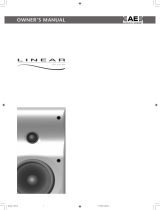Page is loading ...

series
Owners Manual
radiance

2
Introduction
Thank you for purchasing these Acoustic Energy Radiance
Series loudspeakers.
These high-performance loudspeakers utilise some of the
nest materials and most advanced technology available.
They are voiced according to Acoustic Energy’s core values
of musicality, timing, neutrality and, above all - realistic
reproduction of the source material.
More than any other Hi-Fi product, speakers are sensitive
to installation so please take a little time to read this manual
and follow, where practical, the guidelines it contains.
Careful installation will help ensure that your Radiance
speakers perform optimally. Should you have any questions
not covered here please take a look at the support section on
our website - www.acoustic-energy.co.uk
Radiance Series loudspeakers should provide years of
maintenance-free enjoyment and are guaranteed against
defects in materials, manufacture and workmanship for three
years from the date of purchase. For full details please refer
to the Warranty section on page 5 of the manual.
This manual covers all Radiance Series except Radiance Sub.
Technology
The Radiance Series loudspeakers incorporate various
advanced technologies, including -
· Aluminium drive units
· Ring-radiator tweeters
· Curved, acoustically braced cabinets
· DXT® lens
Most interesting of these features (and a rst for Acoustic Energy)
is the DXT® lens. This adjusts dispersion from the tweeters to
match that of the mid/bass drivers.
The lens improves two components of the sound -
Firstly, integration between high and low frequencies is more
natural and seamless than in conventional speakers. This is crucial
for realistic reproduction of the midrange - the human voice in
particular.
Secondly, the lens creates far better integration of sound into the
room environment. This integrated sound is more expansive and
“live” than you would usually hear from a conventional speaker,
while remaining easy to listen to. Detail is abundant but always
part of the musical whole.

3
Installation
Handling - Loudspeakers are relatively delicate, precision
engineered products that can be damaged by inappropriate
handling. Please take care when unpacking or moving them
not to touch any of the drivers. Damage to a driver will at
best degrade performance and at worst result in complete
failure.
Set Up - Radiance one - Ideally the Radiance ones should be
mounted on dedicated speaker stands tall enough to place
the tweeter at, or slightly above ear level from a seated listening
position. The use of wall mounting via brackets or shelf/cabinet
placement are viable alternatives, though performance in these
locations may be reduced from the optimum.
Radiance two/three - As oorstanding speakers both models
require placement clear of room boundaries and should be
mounted on spiked feet (supplied) for best performance. If
spikes are inappropriate for your oor covering, metal
protection pads, coins for example, may be used between the
spike and the oor.
Radiance centre - For use in home theatre systems either
directly above or below the screen. The centre can be stood
on a furniture unit (using supplied rubber feet), integrated
within a screen stand, mounted on a dedicated speaker stand
or on a wall using appropriate bracket hardware.
Connecting
Each Radiance Series speaker has two pairs of binding-post
terminals. These terminals can accept either stripped wire, spade
connectors, or 4mm plugs. Each of these termination methods are
potentially equally eective and the choice is likely to be inuenced
by the type of speaker cable used. Your dealer, distributor or cable
manufacturer will be able to oer advice.
The two pairs of binding posts are mechanically joined via gold-
plated bridging links and can be single or bi-wired.
Single-wiring
Simply connect the speaker cable to the correct polarity terminal on
the speaker (positive - red, negative - black). Either top or bottom
terminals can be used. Ensure the speaker cable is attached to the
amplier in the correct polarity before use. (Note - you will have two
unused terminals, one red, one black on the speaker when wired this
way, this is correct when the bridging links are in place)
Bi-wiring
To bi-wire you will need to unscrew the caps on the binding posts
and remove the bridging links before connection. There are multiple
ways to bi-wire/bi-amp a speaker, consult your Hi-Fi dealer for the
best advice on how to do this with your particular system. They will
also be able to advise on cable choice to best match your system.

4
Home Theatre Positioning
Room layout has a large eect on home theatre systems
due to the number of speakers involved. Below is a
diagram of an optimal layout, this may be hard to achieve
in a typical home so it is worth trying to stick to a few
general points if possible -
· Front left and right speakers should be equal distance
from the centre speaker
·Try to place the front left and right speakers a reasonable
distance apart (where possible) to create a good spread of
sound.
· The height of the rear speakers is not as crucial as the
fronts, they are mainly used for eects and atmosphere
Typical optimum home theatre room layout
Stereo Postitioning
Speaker interaction within the room environment is one of the
largest factors with regards to its performance, having even more
inuence on sound quality than a change of source or amplication.
In an average sized and furnished listening room (say 4m x 5m) you
should aim for a few basic positional points of reference for speaker
placement* -
· Between 0.2 and 0.6 metres from the rear wall
· Between 0.4 and 0.8 metres from side walls
· Between 2.5 and 3.5 metres apart
· Clear of corners
· Maximum toe-in of 15° towards listening position
*These are guidelines only - positioning should be tailored until you nd a preferred sound in your room.
Typical optimum stereo room layout

5
Listening
It is wise before listening to your speakers to make one nal
check of the cables and connections. If all appears well, begin
listening at a relatively low level to conrm the system is
operating as expected. Only increase the volume if you are
happy that the sound at low levels is fundementally as
expected. If you are not convinced all is functioning correctly,
turn o the system and re-check all the cables and
connections.
If you are concerned about any aspect or operation of the
system consult your Acoustic Energy dealer or distributor for
further advice.
Radiance Series speakers may take a little time to “run-in”, and
similarly the system will also take some time to reach normal
operating temperatures. It is unwise therefore to make rapid
judgements about the performance of the speakers. Your ears
too will take some time to adjust to a new sound, so revisiting
the system set-up, speaker positioning especially, is best left
for a few days.
Always try to begin listening with the speakers where you feel
they will perform best, facing straight on while sat in your
main listening position. From there adjust toe-in and oor
placement to optimise the sound to your preference.
Warranty
Under this warranty Acoustic Energy agrees to repair any defect or,
at the company’s discretion, replace any faulty component(s)
without charge for parts or labour. This warranty does not imply any
acceptance by Acoustic Energy or its agents for consequential loss
or damage and specically excludes fair wear and tear, accident,
misuse or unauthorised modication.
This warranty is applicable in the United Kingdom, United States of
America and Canada only and does not in any way limit the
customer’s legal rights. If you have reason to claim under the
warranty please contact your Acoustic Energy dealer in the rst
instance.
Claims and enquiries under the warranty for Acoustic Energy
products purchased outside the UK, USA or Canada should be
addressed to the local importers or distributors.
Please retain all original packaging for future use.

6
Specications
Model:
Type:
LF Driver:
LF/MF Driver:
HF Driver:
Cabinet:
Frequency Respnse:
Power Handling:
Impedance:
Sensitivity:
Dimensions (HxWxD):
Weight:
Radiance 1 Radiance 2 Radiance 3 Radiance Centre
2-way, reex loaded 2.5-way, reex loaded 3-way, reex loaded 2.5-way, reex loaded
N/A 130mm pressed alloy 160mm pressed alloy 130mm pressed alloy
130mm pressed alloy 130mm pressed alloy 130mm pressed alloy 130mm pressed alloy
25mm Neodymium 25mm Neodymium 25mm Neodymium 25mm Neodymium
Ring Radiator with DXT Ring Radiator with DXT Ring Radiator with DXT Ring Radiator with DXT
Curved, braced 15mm Curved, braced 15mm Curved, braced 15mm Curved, braced 15mm
MDF carcass MDF carcass MDF carcass MDF carcass
50Hz to 45kHz ± 3dB 45Hz to 45kHz ± 3dB 40Hz to 45kHz ± 3dB 55Hz to 45kHz ± 3dB
150W peak programme 175W peak programme 200W peak programme 150W peak programme
8 Ohms 8 Ohms 8 Ohms 8 Ohms
88dB for 1 Watt at 1M 89dB for 1 Watt at 1M 90dB for 1 Watt at 1M 88dB for 1 Watt at 1M
320 x 185 x 255mm 920 x 185 x 255mm 920 x 230 x 297mm 185 x 450 x 297mm
(12.6 x 7.3 x 10.0 inches) (36.0 x 7.3 x 10.0 inches) (36.0 x 9.0 x 11.7 inches) (7.3 x 17.7 x 11.7 inches)
8kg (single, unpacked) 16kg (single, unpacked) 18kg (single, unpacked) 8kg (single, unpacked)

7
Products that diplay the crossed-out wheeled bin logo
cannot be disposed of as domestic waste, but must be
taken to a facility capable of re-cycling them and
appropriately handling any waste by-products. Contact
your local authority for details of the nearest such facility.

Acoustic Energy Ltd, 16 Bridge Road, Cirencester, Gloucestershire GL7 1NJ
Tel +44 (0)1285 654432 Fax +44 (0)1285 654430
Email: info@acoustic-energy.co.uk
Web: www.acoustic-energy.co.uk
Manual Part No. MA4101
series
radiance
/










